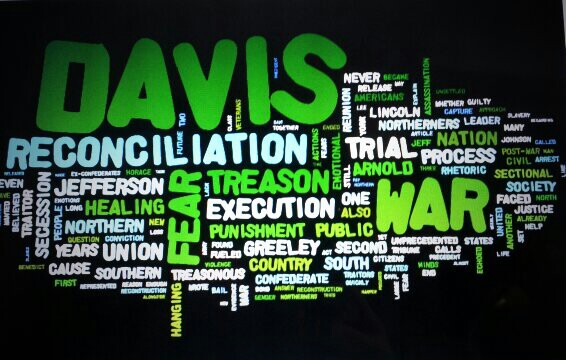
Hello, blog world! This is my first official blog for my 2014 Mellon summer research grant which is sponsoring my project, Jeff Davis, A Sour Apple Tree, and Treason: Fear in the Post-Civil War North. I am so excited to officially begin the research process! The idea for this project began a little more than a year ago, when I took a class at Gettysburg College titled Reconstruction and the Legacy of the Civil War. I went into the class not knowing much about what occurred after the fighting stopped in early 1865, and having absolutely no idea what ‘historical memory’ was or even meant.
The class, though, could not have been offered at a better time during my college career. Taken during the spring semester of my sophomore year, I had yet to discover what exactly my historical passion was. I came to Gettysburg with a genuine interest in the Civil War, not really knowing what I wanted to focus on, but learned through this class that my interest really lies in the Reconstruction era. My term paper examined the question of why the top Confederate leaders were not punished after the war. I chose to concentrate on Jefferson Davis, and why he was never tried or executed after his capture. I discovered a passion for this important yet unanswered question, which became the driving force behind my current research project.
The end of the American Civil War raised many questions, the main one how to piece the torn nation back together after four devastating years of fighting. With Abraham Lincoln’s assassination occurring five days after the Confederate surrender to Ulysses S. Grant, the exact course of how to survive Reconstruction was unknown. Would the Southern states be accepted back into the Union with no punishment? Or would the federal government harshly reprimand the former Confederacy as a warning against future rebellions?
An even more pressing question was how to handle the former Confederate leadership, chiefly Jefferson Davis. The ex-President of the Confederate States, his capture in Georgia by Union cavalry and imprisonment at Fortress Monroe raised the thorny question of what to do with him. With Lincoln and Andrew Johnson offering no clear solution on how to punish the rebels, Northern society had no guidance on how to move forward into Reconstruction and begin the healing process. Some Northerners – Union veterans, ex-slaves, religious leaders, politicians, and citizens – outspokenly called for Davis’s execution , a “quick fix” to the four bloody years of war. Others desired his release from prison with no further punishment.
The lack of uniformity amongst Northern society points to the larger issue that Northerners wrestled with on how to effectively achieve sectional reconciliation. Would Davis’s execution, in fact, be the quick fix that many hoped would help push the nation towards a fuller and more complete healing? Or would it do precisely the opposite, and cause the Southern states to erupt, yet again, in rebellion?
These questions were undoubtedly running through the post-war minds of Northerners, causing them to embrace sectional healing and reconciliation out of sheer paranoia, out of fear. While other historians like David Blight, Nina Silber, and Heather Cox Richardson have advanced arguments for embracing reconciliation in the months and years after Appomattox, scholars have reached little consensus as to the chief engine of sectional reconciliation. Blight insists that an ugly racism helped reconcile the North and South. Silber suggests that gender provided essential political metaphors that helped to heal the war’s wounds. Richardson argues that the imperatives of class and commerce put the nation back together. While each are convincing in their own right, these accounts, in the end, are not entirely satisfying.
Fear, on the other hand, offers a richer and more human explanation to the gaps in the historiography. Though few scholars have written either specifically or at length on the question of Davis and treason, the calls for and against his execution reveal much about the emotional state of the country in the preliminary stages of Reconstruction. While some sought retribution after the war, others preached reconciliation to avoid a second one. My project will specifically analyze and interpret the role that fear played in sparing Davis from the gallows, and why Northerners were so eager to forget the four bloody years of war.
Throughout the course of the summer, I will be diving into the archives at various research repositories, a few of them being Museum of the Confederacy, Jefferson Davis Presidential Library, New York Public Library, National Archives, and Library of Congress. I will be probing for an answer to this question that has stumped not only me but other historians. Stay tuned for updates!

